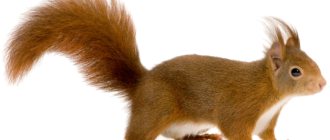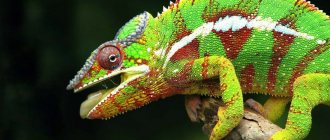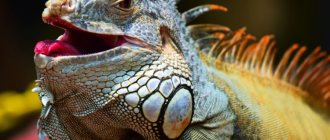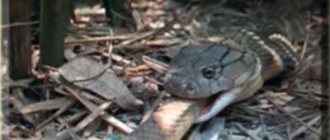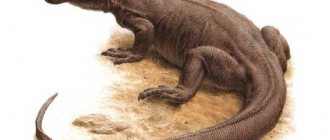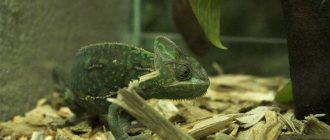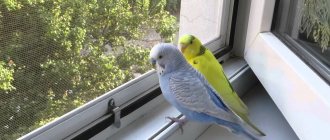The snake family has about two thousand species. The most common of them are water and ordinary (or land). To keep a pet snake, you need to create all the conditions for its life. An amateur serpentologist should familiarize himself not only with the rules of keeping and breeding, but also with the technique of feeding the snake. Often, a tiger snake with an interesting, multi-colored ring color is chosen for captivity. So what is he like, a domesticated one, what kind of approach and maintenance does he require?
Terrarium for snake
If the desire to keep a pet snake does not leave you, first of all you should acquire a spacious terrarium, most of which will be occupied by a swimming pool. A swimming pool is an essential attribute for a pet reptile. It should not be too small in size, at least 50x40x40 cm. Also, the pond should not be cramped so that the pet can easily take a bath in it.
The terrarium must be tightly closed with a net, otherwise the pet snake may escape from its house. It is recommended to lay the bottom of the container with moisture-retaining peat or sand.
In addition to the main soil, a small part is lined with wet moss so that the snake can hide in it. Also placed in the terrarium:
- various driftwood,
- decorative stones,
- shelters made of strong branches or bark, between which the snake will crawl.
Another important nuance is maintaining temperature balance. In one corner it should be slightly raised. To do this, a special warming lamp is placed, and a stone is placed under it, on which the snake will bask. It is also recommended to place the area with damp moss in a warm corner. During the day, the temperature in this area should not be below 33 degrees.
In addition to the heating zone, there should also be a cool place. It is best if it comes with shelter. The temperature in this zone should not exceed 23 degrees. During the daytime, the entire remaining part of the terrarium should be maintained within 22-27 degrees. At night, heating and lighting are turned off, since the pet snake is only awake during the day, and at night it rests in its shelter.
It is very important to properly maintain not only the temperature but also the humidity inside the snake house. This requires constant spraying of soil and moss with water. Ultraviolet light will also be important, although in the summer you can get by with sunbathing.
Nutrition and lifestyle
The snake feeds mainly on amphibians such as frogs, toads and newts. But its menu also includes fish, small birds, mice and lizards. While still young, it feeds only on tadpoles, larvae and very small frogs.
When searching for food, the snake recognizes its prey by smell, which it catches with its tongue and transfers to Jacobson's organ for analysis. Since some types of frogs can inflate, the snake attacks from behind so that they do not have time to do this. If the frog does not inflate, then the victim will be completely absorbed.
The snake prefers to be active during the daytime, especially during warm hours, when it can soak up the sun. In the evening he goes to his hiding place. Large stones or old tree trunks can serve as them.
Snakes spend a lot of time in the water and are excellent swimmers. Usually, when swimming, the head sticks out of the water.
Feeding
A novice serpentologist should first familiarize himself with what can be fed to snakes at home. A delicacy for aquatic reptiles are:
- frogs
- small live fish.
Land breeds prefer to eat mice. In ancient times, many villagers kept snakes in their homes as a rodent hunter.
Snakes quickly adapt to captivity, begin to eat the food given to them, and soon they are completely tamed and become completely domesticated.
Snake food can be purchased at any pet store, but you should not purchase it at the poultry market, as there is a high risk of infecting your pet with helminths.
The snake needs to be fed twice a week. The frogs it feeds on must be medium-sized to avoid blockages in the digestive tract, which could cause death. For a snake thirteen centimeters long, one meal requires a four-centimeter frog, or two very small ones. You can feed snakes with both live and defrosted food. However, it is often not worth giving him defrosted fish. He can handle live feeding himself, but he will have to take the defrosted food with tweezers and gently rock it to the pet. Snakes only respond to movement and will not eat stationary food. Snakes also require a lot of drinking water.
Habitat
Snakes are found in a variety of waters. This is an ideal environment for them to live. Snakes love running water, lakes, ponds or swamps with lush vegetation for protection from predators. They are often found in sand and pebble ponds, as well as in garden ponds in cities. Snakes prefer dry places during mating, for hibernation and for laying eggs.
They can also live in areas away from water, such as forests or forest edges, parks, etc., but this is not their preferred environment.
Shedding
The owner of a pet snake must be prepared for the pet's annual molting period. The main sign of the approach of this period is the clouding of the reptile’s eyes. She begins to see poorly due to dead scales in her eyes. During this period of time, the snake can be easily captured on camera without causing inconvenience or damage to its health. Typically, photo flash is harmful to reptiles. But we should not forget about the increased aggressiveness of reptiles during this period. They can confuse your hand with an enemy or food and bite, so a novice snake lover needs to be extremely careful.
Land and aquatic species are not poisonous, but inflammation may occur after a bite. If suddenly a bite occurs, the wound must be spread apart so that the blood can drain.
The pet may not completely replace the entire skin with a new one. If scraps of rags appear on the snake’s skin, this is a reason to be wary. Usually the skin hangs in rags if the owner does not properly care for his pet. In this case, the reptile needs to be helped to shed:
- A warm bath is made in which the snake is placed.
- As soon as the skin gets wet, remove it with gentle rotating movements.
- If the skin near the eyes is difficult to remove, you should use tweezers and carefully remove it.
In the future, it is recommended to consult a veterinarian for advice.
Offspring
About two to three months after mating, the female lays 10 to 35 eggs in warm, sheltered areas. For this purpose, she chooses shelters such as old tree trunks, reeds or compost heaps.
Mass oviposition also occurs very often. This causes the females to lay their eggs in one pile. Therefore, there are often nests in which 100-200 eggs are collected together. They are usually 25-40 millimeters long and 15-20 millimeters wide.
Within a month, offspring appear. For its birth, the ambient temperature must be around 28 C. If there are bad weather conditions, the hatching period may increase to 60-70 days.
Small snakes are usually born in early autumn. The egg shell is cut with the so-called egg tooth. In the first year of life, young individuals stay overnight in their nest. After four years he becomes an adult. On average, the lifespan of these reptiles is 20 years.
Wintering
By maintaining regular nutrition, your pet snake does not need to spend the winter, especially if it is still very young. However, if during the winter it refuses to eat, or you plan to prepare your pet for reproduction, you definitely need to arrange hibernation, while observing a list of certain rules.
- The reptile must be placed in a well-ventilated cage, protected from light, after filling it with sphagnum moss.
- The temperature should range from approximately 6 to 9 degrees.
- Over the course of two weeks, the temperature must be gradually reduced, making sure in advance that the reptile has completely digested the last food it consumed.
- In the process of removing the pet from the winter, on the contrary, the temperature gradually rises.
- To maintain moisture in the cage, you should periodically spray the soil with water.
In normal conditions, wintering lasts about two months.
It is definitely worth considering that in home conditions there is a high risk of losing a pet when putting it into hibernation. It will be much easier to keep a tropical snake at home, which in natural conditions never hibernates.
Ordinary: description
This reptile belongs to the family of snakes, and differs from its snake relatives by the presence of peculiar yellow “ears”, which represent marks located closer to the neck area. The color of these markings can be lemon, orange, off-white or almost invisible.
As a rule, adults grow up to 1 meter in length, although there are individual specimens whose length reaches almost 2 meters. Males are significantly smaller than females. The head of the common snake is noticeably separated from the body, while its tail is almost 5 times shorter than the body length.
The upper part of the reptile's body may have a dark gray, brown or olive color, on which you can see a dark checkerboard pattern. The lower part of the body is colored in lighter shades of light gray or off-white, with a dark longitudinal stripe running down the center. Some individuals are characterized by the fact that such a stripe runs along the entire lower part of the body. Among these reptiles you can find both albinos and melanists.
Similarities with vipers
It is quite natural that many do not know how to distinguish a snake from a viper, so they mistake it for a poisonous snake.
Interesting to know! In fact, there is very little in common between a snake and a viper. Firstly, they may have a similar living space associated with ponds, forests and simply lawns, and secondly, like many vipers, they try to avoid meeting people.
Among other things, vipers are more aggressive and can attack a person if they don’t like something.
Characteristic differences include:
- The viper, compared to the snake, has a shorter body, and the transition from body to tail is not so smooth.
- You can see yellow spots on the head of the snake, and the viper has a zigzag stripe along its back.
- The snake's head shape is oval and more ovoid, while the viper's head shape is triangular and more like the tip of a spear.
- Snakes do not have poisonous fangs.
- In snakes, the pupils of the eyes are located vertically or have a round shape, while in the viper they are located horizontally, in the form of rods.
- Snakes love to feast on frogs, and vipers prefer rodents.
There are other differences, but they are not worth mentioning, since for a non-specialist it is very difficult to understand, especially in extreme conditions when there is a possibility of a snake attack.
Don't hurt snakes (Already common)
Natural habitats
The habitat of these reptiles is wide, especially since it includes northern latitudes, right up to the Arctic Circle, not to mention the southern latitudes, where the habitat reaches almost the Sahara. If we talk about the western and eastern borders, they pass through the British Isles and the Iberian Peninsula, as well as the central territories of Mongolia and Transbaikalia, respectively.
Snakes adapt quite easily to various living conditions. The most important thing is that there is a body of water nearby, of any origin, preferably with stagnant or weakly flowing water.
These reptiles can be found without problems in meadows, thickets of forests, steppes, swamps, floodplains, urban wastelands, parks, gardens, and also in mountainous areas.
They often settle in cities and love to bask on the asphalt, which is why they often end up under the wheels of vehicles. This factor has a decisive influence on the total number of snakes living in densely populated areas. As for the global scale, the number of snakes is sufficient for them not to worry about.
How long does he live?
As for snakes, the life expectancy of this family is quite impressive and averages 20 years, or even more. The main condition is the presence of water, because it is not for nothing that its scientific name corresponds to the Latin “natrix”, which means “swimmer”.
Interesting Facts! Snakes consume a lot of water and love to take water procedures, carrying out long swims just like that, aimlessly. As a rule, they move along a body of water along the coastline, and some individuals have been seen even in the open sea or at a considerable distance from the shore of large bodies of water. This distance can be tens of kilometers.
Lifestyle
The method of movement in water is no different from the method of movement of other types of snakes. It raises its head vertically above the water and bends its body in a horizontal position in a wave-like manner. When hunting for food items, it can dive deep, while in a state of rest it can lie down at the bottom or wrap its body around a snag that is under water.
Snakes go hunting starting in the early morning and the period of activity ends late in the evening. When it’s warm outside and the sun is shining brightly, snakes can be seen on stumps, on stones, on fallen tree trunks or in any other comfortable place where they bask in the sun’s rays.
With the onset of darkness, they hide in shelters, which can be located among the roots of various trees, among stones or in burrows.
Natural enemies
It is very important for snakes to hide in a shelter in a timely manner after sunset. When the snake's body cools down, it ceases to be active and will not be able to escape from its various enemies. The natural enemies of the common snake can be considered:
- Various predatory animals, including fox and hedgehog.
- Up to 40 species of large birds, including stork and heron.
- Rodents such as rats.
- Amphibians, including frogs and toads.
- A trout that won't give up on young ones.
- Ground beetles and ants that destroy egg laying.
Having met one on one with its enemy, it begins to hiss and flattens the neck area to appear like a poisonous snake. At the same time, his body is located in a zigzag shape, and his tail twitches nervously. There is a second option, more obvious, when one is trying to avoid such a meeting by running away.
Interesting moment! If it ends up in the clutches of a predator or in the hands of a person, it will try to pretend to be dead or begin to secrete a smelly substance.
It is very important for snakes to have good shelter, which is sorely lacking. In this regard, snakes use various objects of human economic activity. They settle in houses and other outbuildings, as well as in compost heaps and garbage dumps.
What does it eat?
The basis of the diet of the common grass snake is fish and frogs, although it can happily expand its diet if possible by:
- Tritonov.
- Toad.
- Lizards.
- Chicks that have fallen out of their nests.
- Newborn water rat cubs.
- Insects and their larvae.
Snakes never feed on carrion and do not consume plant components, but they happily drink milk if they find themselves in an artificial environment.
When hunting fish in the water, it freezes and waits for them to swim as close as possible, after which it attacks them with lightning speed. Frogs can be chased both in water and on land, while the frogs do not try to jump to a safe distance, believing that it is not dangerous for them.
The reptile swallows the caught fish without much effort, but with the frog you still have to tinker if you can’t immediately grab it by the head. This process often takes several hours, as the frog sometimes escapes from the deadly embrace, but then grabs it again and the process continues. After the frog is inside the snake, he goes to rest, since this dish lasts him almost a week. It should be noted that one can go without food for months.
Important point! A German naturalist subjected the snake to a “terrible” test, not allowing it to eat for 10 months. After this period, he fed his experimental subject, but did not notice any problems with the functioning of the gastrointestinal tract.
Reproduction
At the 3rd or 4th year of life, individuals become sexually mature and ready to reproduce. The mating season occurs in April/May, but grass snakes begin laying eggs in July/August. At the same time, mating periods may have some differences, depending on the habitat. Despite this, this period begins after the first molt. According to some reports, snakes can mate in the fall, but the female begins to lay eggs only with the onset of spring.
The mating process is accompanied by the weaving of several individuals into a ball, which may contain one female and several males. As a result of mating, the female lays several pieces of leathery eggs, the number of which can reach 100 pieces, or even more.
Interesting fact! In the event that it is not possible to find a sufficient number of secluded places for laying eggs, females form a collective storage for eggs. One day, in a forest clearing, under an old door, a collective clutch of more than a thousand eggs was discovered.
In order for the clutch to develop normally, the female looks for a suitable warm place with suitable humidity.
Having laid eggs in a prepared “incubator” of sorts, the female crawls away, leaving her offspring to fend for themselves. After about a couple of months, offspring are born, up to 15 cm long, maximum. Having been born, they already begin to look for wintering places.
Before the onset of real cold weather, not all urchins manage to obtain food for themselves, although, despite this, they survive the cold without problems.
How long does he live?
By creating comfortable living conditions and following the menu of what snakes eat at home, their life expectancy can be over twenty years.
Did you like the article?
Take it to your wall and support the project! If you dream of a pet that is more unusual than cats, dogs and fish, which will surprise guests, do not rush to get exotic snakes or spiders. Think about such an ordinary inhabitant of our latitudes as the snake - he is as beautiful and interesting to watch as any other snake, but at the same time does not pose an immediate threat to the life and health of his owners.
The modern animal lover can easily find all the information on how to keep a snake at home on the Internet. In turn, a competent consultant in a specialized store will help you organize this knowledge and make a complete list of what you need.
Hibernation of snakes when kept at home
In order for an ordinary snake to hibernate, its owner must provide it with the proper conditions for this. With the onset of autumn, over the course of 30 days, it is necessary to gradually reduce daylight hours to 4 hours and do the same with the heating period.
After such preparation, lighting stops completely. The temperature in the terrarium is reduced to 10 degrees. As a result of such actions, it goes into hibernation and spends about two months in this state. Such a break in the reptile’s activity is necessary so that in the future it will develop well and reproduce to the delight of its owner.
What does he like?
The main diet of snakes consists of lizards, fish, various amphibians suitable for snakes in size, and less often chicks and rodents. Snakes live in places where there is some kind of body of water nearby.
Interesting materials:
Which drills are for what? What are the properties of laundry soap? What kind of dances are danced in Mexico? What are the currents of the Western Winds? What topics do you need to know to pass the GPA in mathematics? What themes does the author touch upon in Kosca's story? What territories were part of Yugoslavia? Which tigers are becoming extinct? What products cannot be sold? What trams are currently running in Kyiv?
Interesting things about snakes
- To completely remove the skin during molting, the snake finds narrow cracks and crawls through them. Thus, the skin slides off the animal, like an inverted stocking (this starts from the head).
- The bite does not pose any danger to humans.
- Residents of small villages often domesticate wild snakes so that these non-venomous snakes exterminate rodents on the farm.
- Snakes swallow prey alive without killing it first.
- When the weather is too hot, the reptile can sink to the bottom of the reservoir and stay there for quite a long time, waiting for its body to cool down.
- If a snake is in danger while it is swallowing food or has just swallowed it, the snake regurgitates the food and flees or tries to defend itself. In this case, a mouse or frog that has been in the mouth of a reptile may remain alive.
Is it really dangerous for humans?
Since it is not a poisonous snake, it does not pose a serious danger to humans. Moreover, these creatures don’t even know how to bite, so even if they wanted to, they couldn’t do any harm. The most a cold-blooded person can do is lightly scratch the skin with his teeth. So, when meeting a snake, you should not panic or be afraid. Moreover, he will probably try to hide from sight.
True, despite its harmlessness, the animal has a couple of ways in its arsenal to help scare away an uninvited guest. When a cold-blooded animal does not want to get involved with a person, it is capable of rearing up and making a loud hissing sound. If this does not help, it can shoot out a pungent odorous liquid from the cloaca. It will not cause physical harm, but it will relieve you of the desire to approach the snake.
Not dangerous to humans
Interesting fact : the tiger snake feeds on poisonous toads, the liquid from which fills the glands in its mouth. During a bite, it can get on the skin, causing swelling and burning. Because of this, tiger snakes can be called poisonous.
If the snake did not manage to scare away the person with its “techniques”, and he took it in his hands, the animal in most cases will not even resist. It may also try to play dead by hanging its head down. In this case, for greater reliability, the snake sometimes regurgitates the remains of undigested food in order to finally convince the offender that it has breathed its last.
Snakes lend themselves well to domestication. They are able to live in houses and apartments, systematically receiving food from the owner and feeling great in confined spaces. With proper care, the snake will turn into an affectionate pet that doesn’t mind lying on its owner’s stomach.
Snake protection
Since snakes do not experience problems with population numbers, humanity does not care much about their protection. Moreover, people often become the reason for the reduction in the number of individuals in certain territories.
Due to regular deforestation, pollution of the environment and water bodies, it is becoming increasingly difficult for snakes to find areas favorable for living. In some countries, certain species of snakes are listed in the Red Book, since the number of their individuals is gradually declining due to various factors.
Reproduction
In a pair of snakes, mating games begin with nodding their heads. This ritual begins with the male holding his head high, shaking it from side to side. If the female accepts signs of attention, she responds to the gentleman with the same gestures. When mutual understanding in the couple is achieved, the “suitor” moves on to more active courtship and rubs himself against the back of his “lady.”
The eggs of the common grass snake contain small snakes whose hearts are already beating, since the development of the offspring begins already in the female’s body. The eggs themselves are not the same as chicken or bird eggs; they are very soft and sticky, which is why they are able to stick to each other. If the terrarium is not humid enough, they will dry out and the offspring will die.
The incubation period lasts about 10 weeks. Young females are capable of laying 10-15 eggs in a clutch, while a mature individual lays about 30 eggs or even more.


